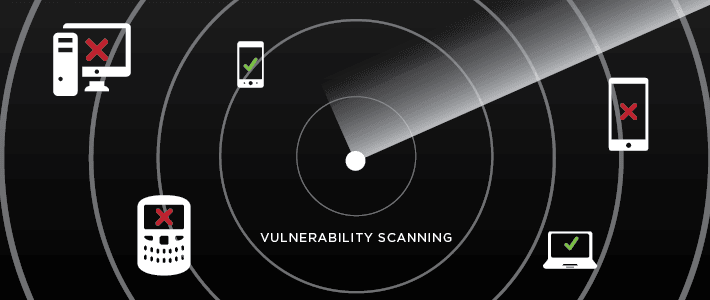Vulnerability scanning is an automated process of proactively identifying network, application, and security vulnerabilities. Vulnerability scanning is typically performed by the IT department of an organization or a third-party security service provider like CyberSecuriosity. This scan is also performed by attackers who try to find points of entry into your network.
Vulnerability scanning is a vital part of your security team’s overall IT risk management approach for several reasons:
- Vulnerability scanning lets you take a proactive approach to close any gaps and maintain strong security for your systems, data, employees, and customers. Data breaches are often the result of unpatched vulnerabilities, so identifying and eliminating these security gaps, removes that attack vector.
- Cybersecurity compliance and regulations demand secure systems. For instance, NIST, PCI DSS, and HIPAA all emphasize vulnerability scanning to protect sensitive data.
- Cyber criminals also have access to vulnerability scanning tools, so it is vital to carry out scans and take restorative actions before hackers can exploit any security vulnerabilities.
The scanning process includes detecting and classifying system weaknesses in networks, communications equipment, and computers. In addition to identifying security holes, the vulnerability scans also predict how effective countermeasures are in case of a threat or attack.
A vulnerability scanning service uses piece of software running from the standpoint of the person or organization inspecting the attack surface in question. The vulnerability scanner uses a database to compare details about the target attack surface.
Properly configuring vulnerability scans is an essential component of a vulnerability management solution. Vulnerability scanners can sometimes disrupt the networks and systems that they scan. If available network bandwidth becomes very limited during an organization’s peak hours, then vulnerability scans should be scheduled to run during off hours.
What to Look for in Vulnerability Scanning and Risk Assessment Tools
The four following capabilities should top your list of priorities when assessing the suitability of a vulnerability scanning for your enterprise:
- Frequency of updates
- Your vulnerability scanner database should be continually updated with the latest identified vulnerabilities
- Quality and quantity of vulnerabilities
- Your scanner should strike the right balance between identifying all vulnerabilities, while minimizing false positives and negatives, and providing high-quality information on flaws, threat priorities, and remediation pathways.
- Actionable results
- Your scanning tool should provide comprehensive reports that allow you to take practical, corrective actions.
- Integrations
- Your vulnerability scanner should fit seamlessly into your vulnerability management program, which should include patch management and other solutions.
Implemented correctly, a vulnerability scanning tool is instrumental to identifying and assessing modern security risk, providing your organization with the insight it needs to take corrective actions, comply with regulatory frameworks, and maintain a strong cybersecurity posture.
Vulnerability Scanning Tools
Web Application Vulnerability Scanners are automated tools that scan web applications, normally from the outside, to look for security vulnerabilities such as Cross-site scripting, SQL Injection, Command Injection, Path Traversal and insecure server configuration.
This category of tools is frequently referred to as Dynamic Application Security Testing (DAST) Tools. A large number of both commercial and open source tools of this type are available and all of these tools have their own strengths and weaknesses. If you are interested in the effectiveness of DAST tools, check out the OWASP Benchmark project, which is scientifically measuring the effectiveness of all types of vulnerability detection tools, including DAST.
Below you can find list of some useful open source tools for vulnerability scanning:
- Arachni
- Type: Web
- License: Free for most use cases
- Platforms: Most platforms supported
- Grabber
- Type: Web
- License: Open Source
- Platforms: Python 2.4, BeautifulSoup and PyXML
- Nikto
- Type: Web
- License: Open Source
- Platforms: Unix/Linux
- Vega
- Type: Web
- License: Open Source
- Platforms: Windows, Linux and Macintosh
- Zed Attack Proxy (OWASP ZAP)
- Type: Web
- License: Open Source
- Platforms: Windows, Unix/Linux and Macintosh
- Nmap
- Type: Network, Web
- License: Open Source
- Platforms: Windows, Unix/Linux and Macintosh
- OpenVAS
- Type: Network, Web
- License: Free
- Platforms: Windows, Unix/Linux and Macintosh

